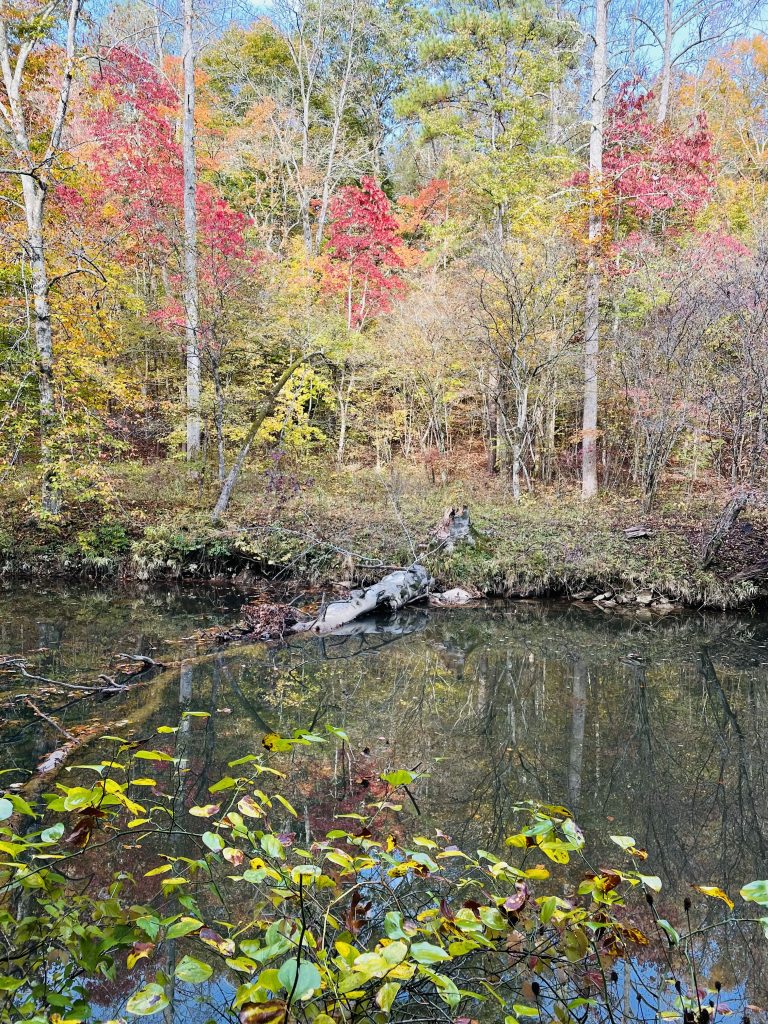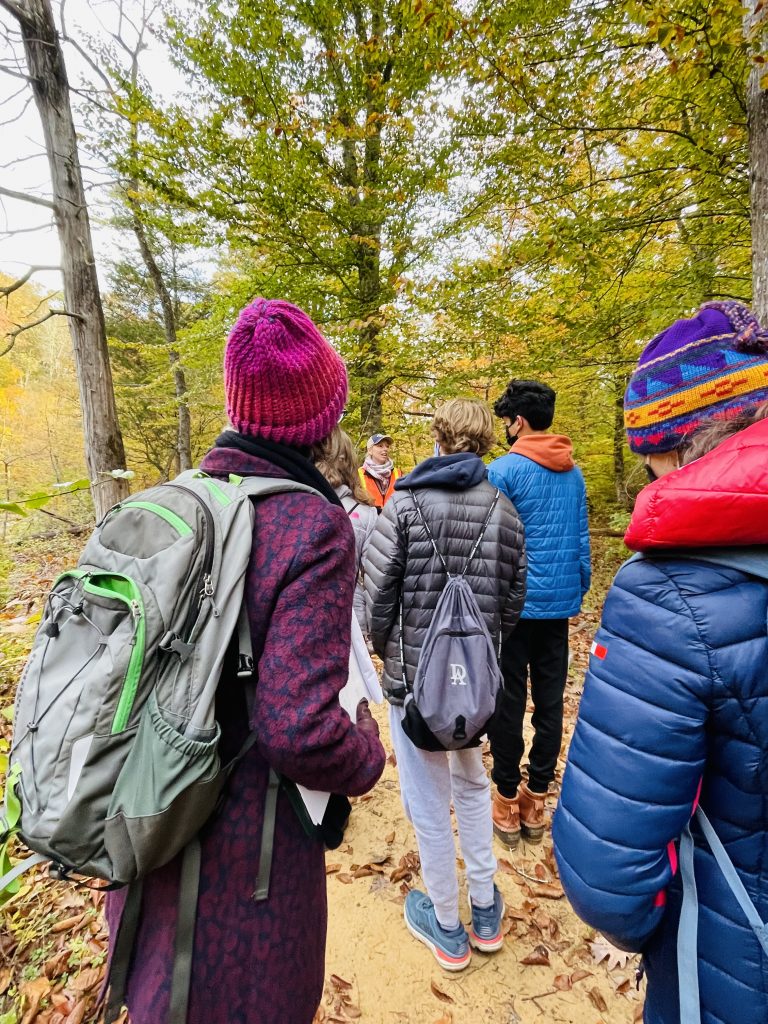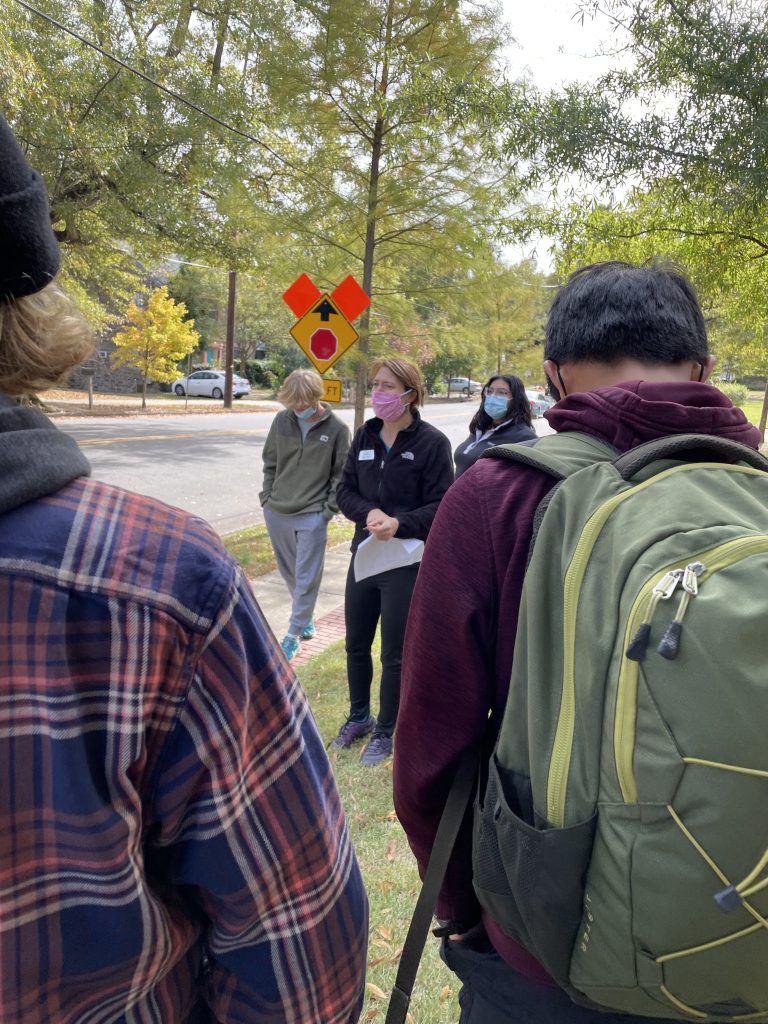Frankie Stover & Ash Granda-Bondurant
“Ever since the seminar, I have paid close attention to how many trees houses have. For example, I was driving through a rural area that I was not familiar with, and I particularly noticed houses that had trees planted in the front, which made me realize how houses with trees just seemed more alive. This interpretation also told me a bit about the history of the house and maybe some of the challenges it may face. Overall, the value of trees in urban areas has increased in my mind.”
-Sanju Patel ‘23
A partnership between the Sustainability Committee and R.A.I.S.E (Raising Awareness for Inclusion and Social Equity) leaders here at Durham Academy resulted in the successful 2021 Fall Seminar: Trees in the forest, City, and Campus. Twenty-one students across five different grade levels attended this event on Friday, November 5th. Our day was split into three parts: learning about trees in the forest with Duke Forest Director Sara Childs, learning about our trees in our urban Durham environment, and lastly focusing on planting trees around our campus.
“The seminar helped me realize how interconnected ecosystems are, specifically Ms. Childs’ explanation of ecological succession and how the toppling of the large tree we saw on the trail allowed other plants of varying species to be exposed to more sunlight and grow. For me, this also emphasized the role of trees in our environment’s biodiversity.”
– Lydia Amanueal ’24

How is it that barren farmland was able to become the forests we know today? How have they become so biologically diverse?
Early Friday morning, We asked these questions in Duke Forest while appreciating and learning more about trees and their ecosystem- both above ground and below it.We were welcomed by Duke Forest Director Ms. Sara Childs, who led us on an informational hike in the Korstian division of Duke Forest. We learned that much of Duke Forest had been abandoned farmland. The land was eroded by the effects of weather such as wind and rain, and the soil lost many of the essential nutrients for the survival of healthy crops from the overuse of land by the farmers. As it became increasingly difficult to continue working the soil, many farmers dropped their plows for good and moved into the growing cities to work. These 7,000 acres of beaten fields were the beginning of Duke Forest.
These farmlands are now marked by tall pine, oak, and other trees in areas where the land was used for farming cotton and tobacco. During our hike, we took a “Tree Appreciation Moment” (T.A.M.) and each picked a tree that stood out to us. We observed the bark, the surrounding plants, even the details of the ground we were standing on. We saw that there were trees just starting to grow on the ground and that the leaves falling off the older trees were in different stages of decomposition. It made us think about the life cycle of these trees and how even the death of things can contribute to the future wellbeing of the greater forest.
After returning to campus from our hike, we spent the rest of our morning hearing from Keep Durham Beautiful director Tania Dautlick. Keep Durham Beautiful aims to engage individuals with their community. Durham Academy’s partnership with this nonprofit focuses on the beautification and community greening aspect in Durham.
As opposed to learning about various aspects and geographic impact of trees, we learned about the urban impact of trees in a community. Specifically, we focused on the effects of redlining in our Durham community. Redlining was a discriminatory practice in which services were denied to residents of certain neighborhoods on the basis of their race or ethnicity. While this practice legally ended in the 1970s, the effects are still obvious decades later. While Keep Durham Beautiful focuses on many aspects of restoring and maintaining previously redlined communities in Durham, we focused on trees and how many of these neighborhoods were denied them.

Ms. Dautlick’s presentation showed that the formerly redlined neighborhoods had and still have fewer trees than those that were not redlined. With fewer trees, these neighborhoods suffer the loss of benefits as opposed to higher income neighborhoods. Based on studies done by Keep Durham Beautiful, the organization was able to note a pattern in redlined communities and their lack of tree canopy. Without it, there’s less shade. With climate change and rising temperatures, trees serve as one solution to reduce air temperatures. The canopy cools the air by shading the surfaces such as concrete and asphalt. This prevents them from heating up in the sun and by transpiring water as they grow, cooling the air just as evaporation would. Having tree equity throughout neighborhoods allows everyone the opportunity to experience the health, climate and economic benefits trees provide.
“The team building of planting trees together as a community gave a wonderful instant gratification. Planting trees then being able to see the wonderful outcome from the act while being able to hang out with others was wonderful.”
– Mark Caveney ’23

We ended our seminar day with tree planting on campus under the direction of two members of our DA maintenance staff: John Richards and Chad McKenzie. We worked by the track and swamp area to plant red cedars and wax myrtles. The red cedars will grow up to form a natural fence between this area and the road. They will end up being 8 feet wide and 32 feet tall. The wax myrtles provide the benefit of absorbing water by the swamp so it doesn’t flood as heavily. They also provide habitat for the birds and insects.
In conclusion, the tree seminar was a great bonding among grades levels 8-12. It was a gratifying feeling to see how our work in planting the trees would benefit the community now and for decades to come. If you want to get involved with tree planting yourself, sign up right here for tree planting at Lyon Park on Saturday the 13th!
“Honestly, tree planting was a whole lot of fun! It was great to see the teamwork involved, knowing that our work can make a big impact not only on our DA campus but also on the broader Durham community.
– Matthew Sun ‘24














Recent Comments